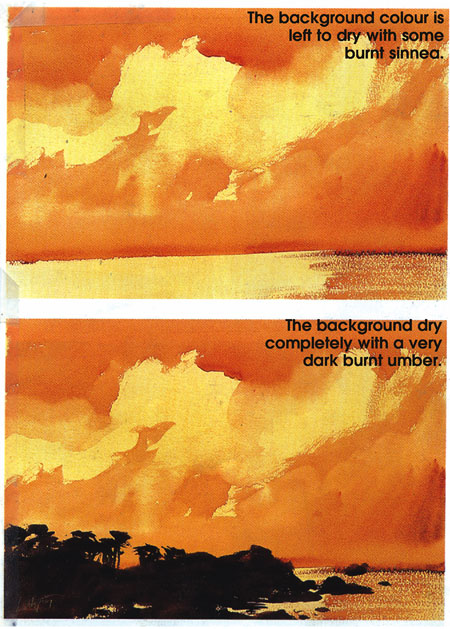|
Learn to draw by Tissa Hewavitarane
The combination of wet and dry techniques
It is difficult to use just the technique of painting on a dry
background in any given painting. Usually, both are used simultaneously
to achieve the desired effect of each, capturing the fusion of tones on
the one hand and the precision of a dry brush stroke on the other.

The only problem is that these two techniques demand completely
different drying times between applications. If the base is wet, the
newly applied paint will spread and merge. If the base is solid, the
brushstrokes will appear definite and precise.
The wet background allows effects of atmosphere, vague shades merging
areas, gradations and the merging and blending of colour. The extent to
which an added colour will spread depends upon the degree of wetness of
the background. Controlling this enables the painter to work with great
precision in the area where the colour is being applied.
The wetness is controlled with absorbent paper, with a sponge a dry
brush or by the natural evaporation of the water. The base is completely
wetted with a sponge or brush after the precaution has been taken of
attaching the paper with some gum tape to avoid swelling and wrinkling.
With the paper upright and quite wet, paint a horizontal brushstroke
along the upper border.
It is important to insist on learning how to control a wash to
understand the basic watercolour techniques. At first wait for the paper
to dry a little. If you paint while the paper is still soaking wet, the
colour will run all over and blend completely. When the background is
still wet, but not soaked a darker colour can be added.
With a drier base, the form of the brushstroke can be controlled much
better, although the paint still runs and blends into the background.
The first picture shows the background colour left to dry almost
completely. With some burnt sienna begin to paint in the dark parts of
the clouds and outline their form.
In the lower area the artist has made use of the dry brush technique
to paint the reflections on the water. The picture below shows the
background being completely dry since we don't want the tones to mix.
With a very dark burnt amber paint this perfectly defined area of back
lighting could be seen.
Since the background is completely dry the tones do not run and
blend. The paper used is Kent with a slight grain and brush No. 3,6 and
8 could be used. |

